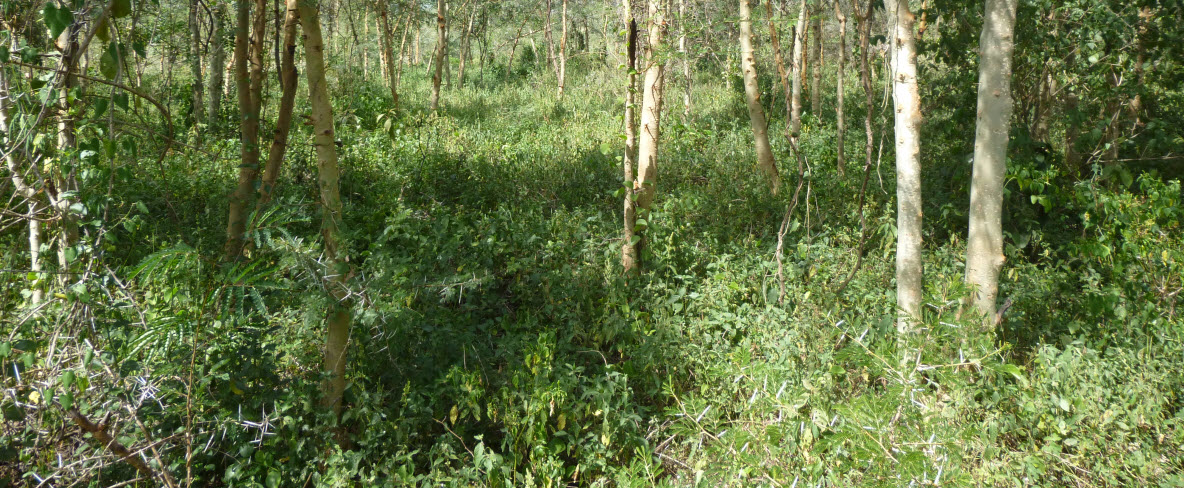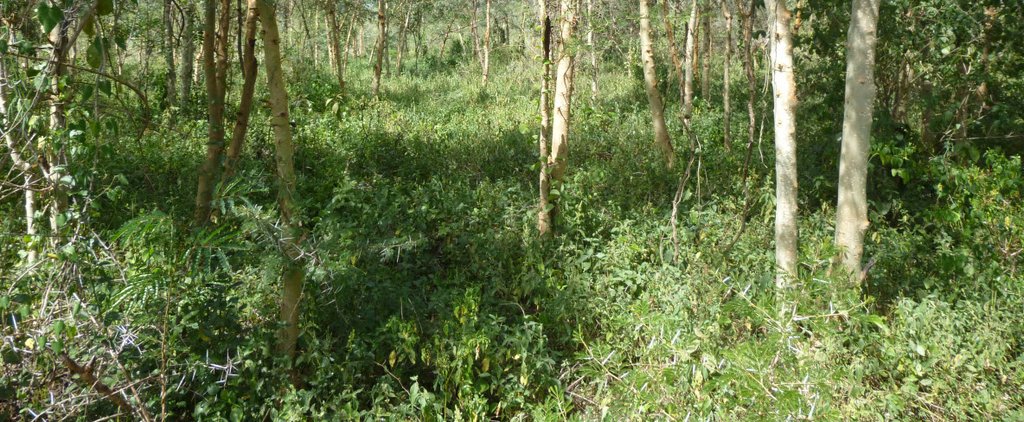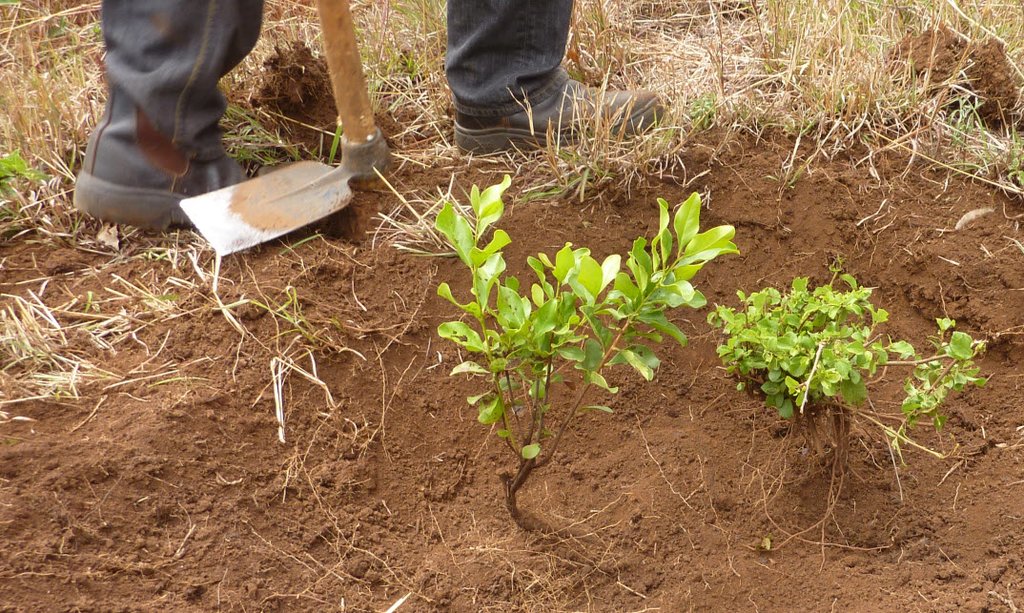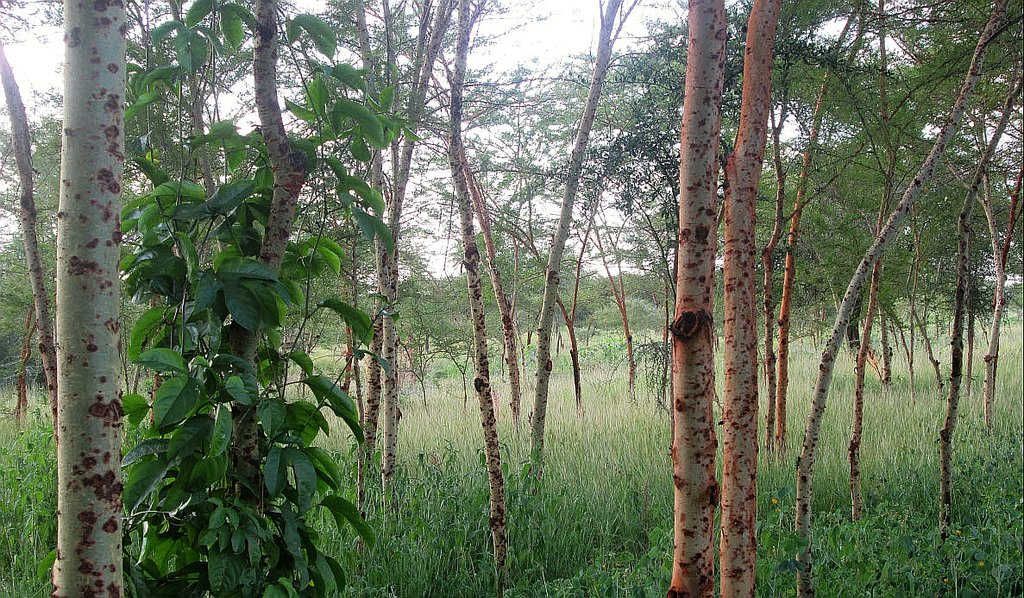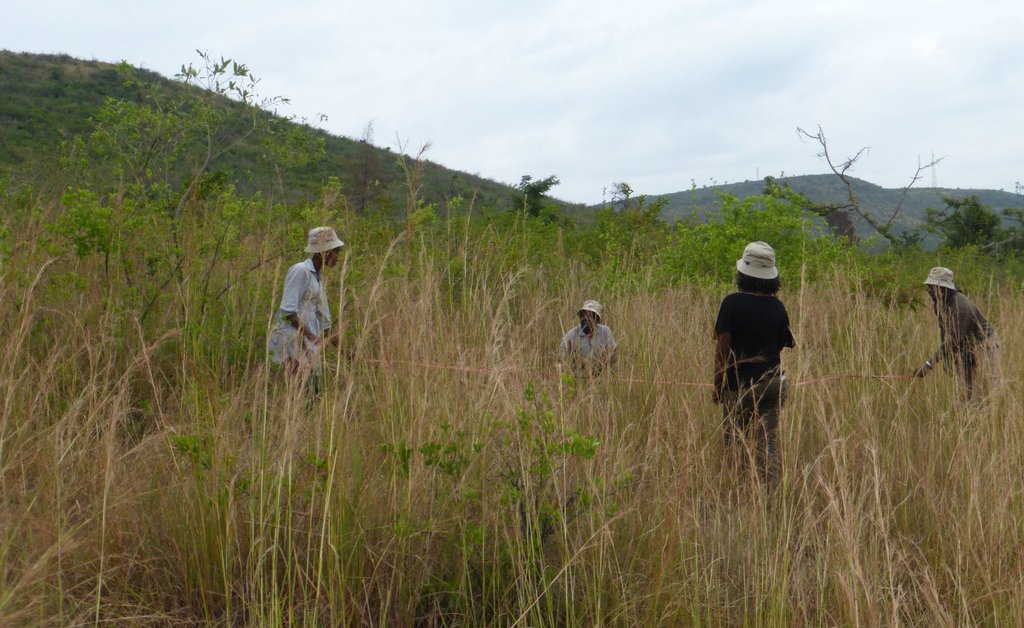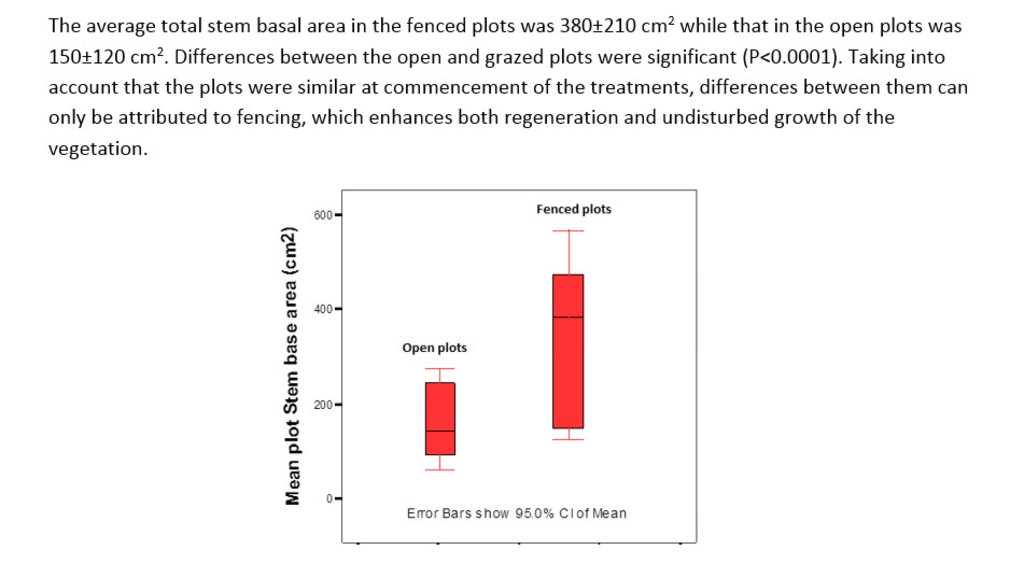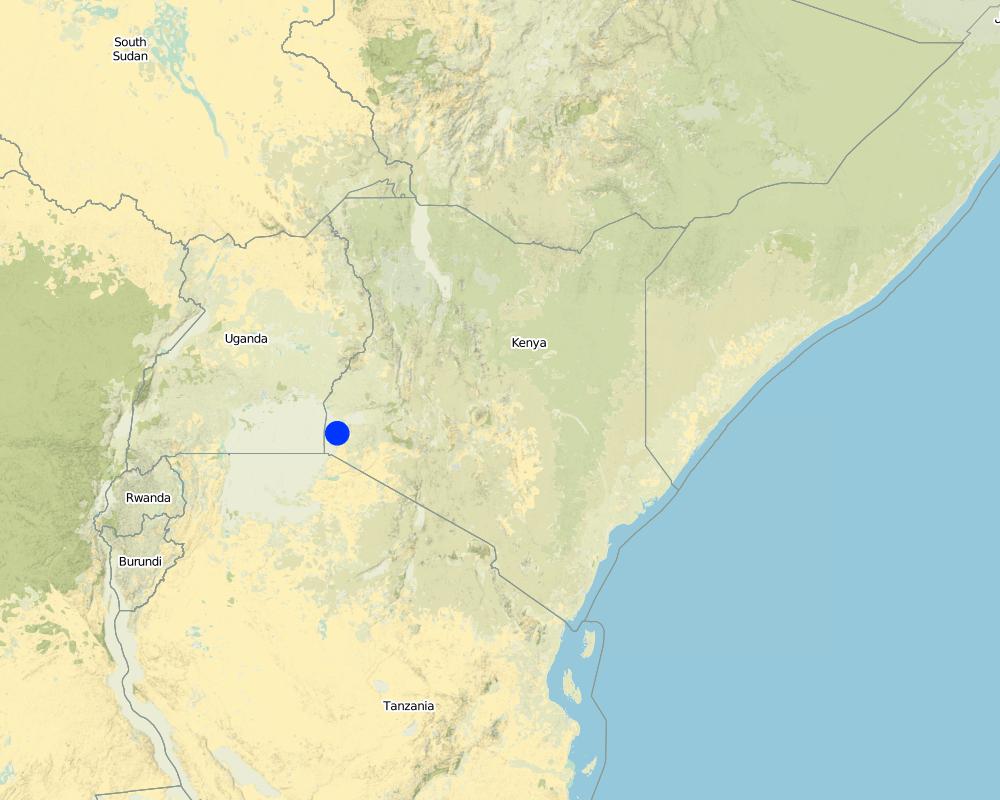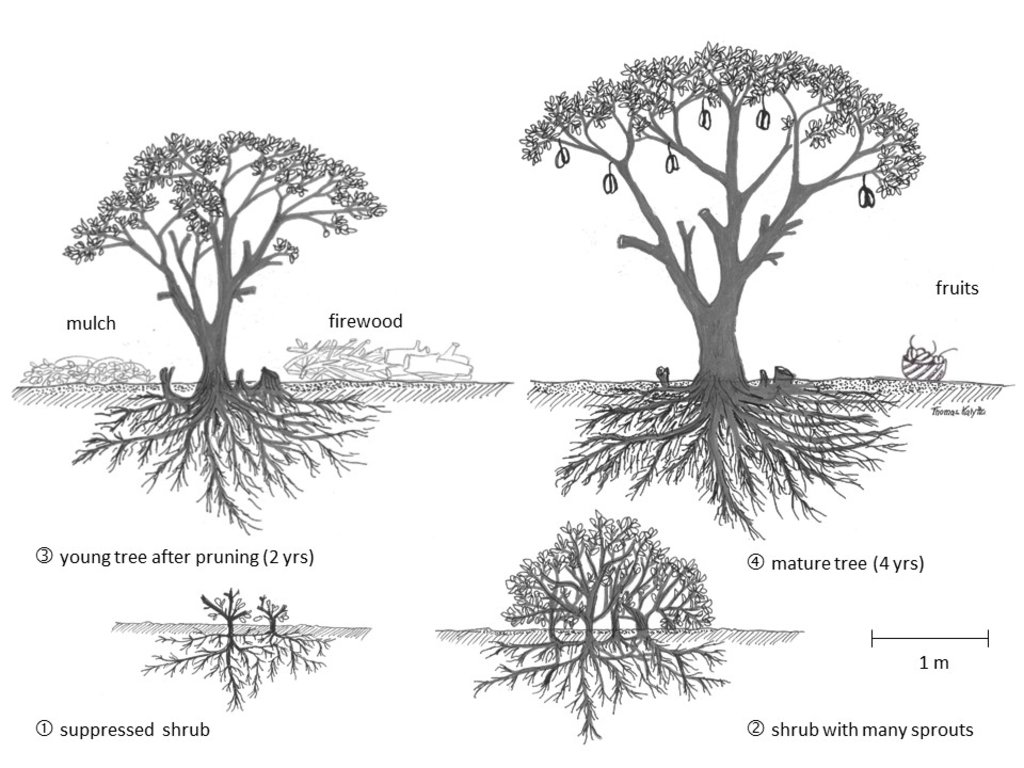Farmer Managed Natural Regeneration (FMNR) [Kenya]
- Création :
- Mise à jour :
- Compilateur : Thomas Kalytta
- Rédacteur : Irene Ojuok
- Examinateurs : Hanspeter Liniger, Nicole Harari, Alexandra Gavilano, David Streiff, Fabian Ottiger, Mathias Gurtner
FMNR
technologies_507 - Kenya
Voir les sections
Développer tout Réduire tout1. Informations générales
1.2 Coordonnées des personnes-ressources et des institutions impliquées dans l'évaluation et la documentation de la Technologie
Personne(s)-ressource(s) clé(s)
Spécialiste GDT:
Ojuok Irene
World Vision
Kenya
Kalytta Thomas
World Vision
exploitant des terres:
Sijenyi Onyiego William
Obanda Environmental project
Kenya
Nom du projet qui a facilité la documentation/ l'évaluation de la Technologie (si pertinent)
Book project: where people and their land are safer - A Compendium of Good Practices in Disaster Risk Reduction (DRR) (where people and their land are safer)Nom du ou des institutions qui ont facilité la documentation/ l'évaluation de la Technologie (si pertinent)
World Vision (World Vision) - Suisse1.3 Conditions relatives à l'utilisation par WOCAT des données documentées
Le compilateur et la(les) personne(s) ressource(s) acceptent les conditions relatives à l'utilisation par WOCAT des données documentées:
Oui
1.4 Déclaration sur la durabilité de la Technologie décrite
Est-ce que la Technologie décrite ici pose problème par rapport à la dégradation des terres, de telle sorte qu'elle ne peut pas être déclarée comme étant une technologie de gestion durable des terres?
Non
Commentaires:
It is a very sustainable technology as it promotes the natural regeneration of highly degraded areas.
1.5 Référence au(x) Questionnaires sur les Approches de GDT (documentées au moyen de WOCAT)
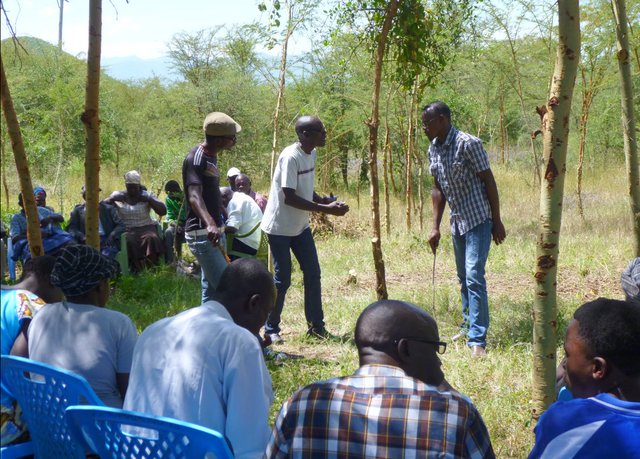
FMNR implementation approach [Kenya]
After consultations with local stakeholders, experts (from NEMA, ICRAF, KFS, Wildlife Kenya) and Homabay County Government representatives the FMNR approach is being introduced by World Vision through a public funded project. The aim of the approach is to promote FMNR and sustainable land and natural resource management through disseminating the …
- Compilateur : Thomas Kalytta
2. Description de la Technologie de GDT
2.1 Courte description de la Technologie
Définition de la Technologie:
Farmer Managed Natural Regeneration (FMNR) is a proven SLM Technology to restore degraded wasteland and improve depleted farmland. The farmer regu- lates and facilitates the re-growth of existing trees stumps, or self-sown seeds in the soil, and thus promotes soil fertility and through better ground cover, increases protection from runoff and erosion.
2.2 Description détaillée de la Technologie
Description:
Conventional afforestation and tree planting requires considerable inputs, labour and care including suitable seedlings, transport of these, planting and regular watering - and the survival rate in arid and semi-arid climates is often very poor. On the other hand Farmer Managed Natural Regeneration (FMNR) is a cheap and effective way to restore and improve large areas of degraded and depleted soils. The technology relies on the fact that even in deforested areas, soils often still maintain some active roots systems and viable seeds of native woody plants. Selectively promoted, leaving only a few main shoots, they can grow into trees within a few years. This technology - based on indigen- ous practices - has been successfully promoted by World Vision in eight African countries including Kenya and Ethiopia, and is now also being applied in Indonesia, East Timor and Latin America. Apart from labour and a farmer’s knife, and skills, there are no major inputs required. The farmers like this agroforestry technology a it is cheap and can be easily combined with other SLM technolo- gies such as permaculture, inter-cropping, and mulching. At the same time it can be used at various scales: on small plots of less than one hectare or up to the landscape level where whole hills can be re-vegetated within a short period. And the impact can be very positive on the soil, ecology, cli- mate and health of crops, people and livestock. The farmer can use prunings as rewood, and grow fodder below the trees; tree branches and leaves can serve for mulching and the owers for bees, fruits for consumption and sale. The trees break the winds, protect the soil and (with some species) their shade protects sensitive crops (e.g. vegetables or even coffee) from the sun. The soil’s water retention capacity, structure, biology and fertility improve. All effects contribute to soil, water and climate stabilization. One limitation can be the use of tractors and other machines which, however, are hardly employed by smallholder farmers. Some practical steps for establishing an FNMR site; 1) jointly agree on a target area (be it a eld or communal wasteland) 2) check out the area carefully for existence of woody species (trees, bushes, rootstocks) 3) mark the bushes or trees that should be nurtured into bigger trees (it is recommended to consult local/scientific knowledge on the trees species and their positive benefits) 4) protect the whole area (fences, hedges) or only the chosen trees against grazing and human disturbance 5) when the plants reach a height of 1 m start with pruning, only keeping the 2-3 main shoots, using the prunings for rewood or mulching 6) watering is in most cases not required as the indigenous trees have well-enough developed roots for self- supply 7) the specific cultivation and management practice depends on the trees species selected and the desired results (intercropping with maize, shade trees for coffee, fodder trees for livestock, flower trees for bees etc.) 8) fire and livestock are the are the main threats for a new FMNR site.
2.3 Photos de la Technologie
Remarques générales concernant les photos:
The photos were taken during 2 years while introducing FMNR to the 1000 small holder farmers in Homabay County.
2.4 Vidéos de la Technologie
Commentaire, brève description:
Tony Rinaudo gives an introduction to Farmer Managed Natural Regeneration Project Model. It is something that can be implemented relatively quickly with a low budget and have a great impact. FMNR has big implications for income generation, Disaster Risk Reduction, reducing proness to famine, conflict reduction, land and forest restoration, food security, climate change adaptation and mitigation... amongst other things.
https://vimeo.com/55277450
Date:
2012
Lieu:
Niger etc.
Nom du vidéaste:
World Vision
Commentaire, brève description:
(Video in German language)
It is a method with a great success: Farmer Managed Natural Regeneration (FMNR). World Vision employee Tony Rinaudo paves the way to grow trees, where hardly anything is produced. Meanwhile, the people in the Humbo region of Ethiopia are earning money from global emissions trade through greening their country. The World Bank is promoting the project and the local people can now provide for a better future. But in the beginning it was not easy for Tony Rinaudo and his colleagues to convince the farmers to protect the forest!
Es ist eine Methode, die durchschlagenden Erfolg hat: Farmer Managed Natural Regeneration (FMNR).
World Vision Mitarbeiter Tony Rinaudo lässt Bäume aufwachsen, wo das Land kaum noch etwas hervorbringt. Mittlerweile verdienen die Menschen in der Region Humbo in Äthiopien durch die Wiederbegrünung Geld im weltweiten Emissionshandel. Die Weltbank fördert das Projekt und die Menschen vor Ort können nun selbst für eine bessere Zukunft sorgen. Doch am Anfang war es nicht leicht für Tony Rinaudo und seine Mitstreiter, die Bauern davon zu überzeugen den Wald zu schützen!
https://vimeo.com/189822143
Date:
26/06/2012
Lieu:
Humbo, Ethiopia
Nom du vidéaste:
World Vision
Commentaire, brève description:
Original (edited) footage of a 1990 visit to Niger where Farmer Managed Natural Regeneration (FMNR) was being practiced. Features an interview with Tony Rinaudo and one of the early adopters. Tony was a SIM missionary who pioneered and developed this management practice. It is now being practiced on millions of hectares in Niger and other countries in the Sahel. Part 1: https://vimeo.com/189821376
Part 2: https://vimeo.com/189821948
Date:
1990
Lieu:
Niger
Nom du vidéaste:
Barry Rands
2.5 Pays/ région/ lieux où la Technologie a été appliquée et qui sont couverts par cette évaluation
Pays:
Kenya
Région/ Etat/ Province:
Homa Bay Country
Autres spécifications du lieu:
Suba and Mbita Sub-Counties
Spécifiez la diffusion de la Technologie:
- répartie uniformément sur une zone
S'il n'existe pas d'informations exactes sur la superficie, indiquez les limites approximatives de la zone couverte:
- 1-10 km2
Commentaires:
Only 16 of the initial FMNR sites are reflected above:
1,-0.55,34.215,1202,Sumba West ,Lambwe,Abong'o agroforestry farm,Mon Sep 01 00:00:00 UTC 2014,Yes,Borehole 4,Bucket or watering can,1,0,1,"Agroforestry management,soil testing and +fmnr",4
2,-0.546,34.209,1223,Sumba west ,Lambwe,Abuto's +fmnr,Fri Aug 01 00:00:00 UTC 2014,Yes,Borehole,N/A,1,0,1,+fmnr farm,,https://wvksurveys.appspot.com/view/binaryData?blobKey=WVK_Livelihoods_2014%5B%40version%3Dnull+and+%40uiVersion%3Dnull%5D%2FWVK_Livelihoods_2014%5B%40key%3Duuid%3A7afa8c53-61f2-46ff-a191-9ebd393b0145%5D%2Fimage_test
4,-0.617,34.333,1171,Ogongo ,Lambwe,Aloice +fmnr demonstration farm,Sat Sep 13 00:00:00 UTC 1997,Yes,"Borehole, Rainwater, lake and Others",N/A,1,0,1,+fmnr Demonstration farm.,3
5,-0.621,34.331,1154,Ogongo ,Lambwe,Arise and Shine Ojawa YG,Wed Jan 01 00:00:00 UTC 2014,Yes,Pond,Bucket or watering can,11,5,6,"Tree nursery, tree planting, +fmnr, bee keeping, maize farming 4acres, Agro forestry, chairs for hire, fruit trees.",10
6,-0.612,34.337,1191,Ogongo ,Lambwe,Clements +fmnr site,Tue Aug 13 00:00:00 UTC 2013,Yes,"Rainwater, lake and Others",N/A,2,1,1,+fmnr established site,1 acre,https://wvksurveys.appspot.com/view/binaryData?blobKey=WVK_Livelihoods_2014%5B%40version%3Dnull+and+%40uiVersion%3Dnull%5D%2FWVK_Livelihoods_2014%5B%40key%3Duuid%3Af68584de-5b53-465a-9177-01159ef0ff3f%5D%2Fimage_test
7,-0.541,34.392,1163,Ruri East,Lambwe,Eliakims +fmnr site,Sun Jun 01 00:00:00 UTC 2014,Yes,Borehole,N/A,1,1,1,Household +fmnr site and bee keeping.,2 acres,https://wvksurveys.appspot.com/view/binaryData?blobKey=WVK_Livelihoods_2014%5B%40version%3Dnull+and+%40uiVersion%3Dnull%5D%2FWVK_Livelihoods_2014%5B%40key%3Duuid%3A825648e7-1fa4-4be8-b051-83adc8748e0b%5D%2Fimage_test
10,-0.562,34.324,1204,Got jope ,Lambwe,Got Jope +fmnr Biodiversity site,Wed Aug 13 00:00:00 UTC 2014,Yes,"Rainwater, lake and Others",N/A,0,,,+fmnr site fenced off for natural re generation,2
11,-0.535,34.406,1172,Got Rabondo,Lambwe,Gotrabondo +fmnr,Tue Jan 13 00:00:00 UTC 2015,Yes,"Rainwater, lake and Others",N/A,,,,Proposed +fmnr site,0.5 acres,https://wvksurveys.appspot.com/view/binaryData?blobKey=WVK_Livelihoods_2014%5B%40version%3Dnull+and+%40uiVersion%3Dnull%5D%2FWVK_Livelihoods_2014%5B%40key%3Duuid%3A544ec602-66ad-4e15-9053-1471c78f53ad%5D%2Fimage_test
19,-0.576,34.368,1243,Godjope,Lambwe,Ngufu youth group,Tue Jan 06 00:00:00 UTC 1998,Yes,Open well,Bucket or watering can,7000,4500,2500,+fmnr site,6Average of 2.5acres per household,https://wvksurveys.appspot.com/view/binaryData?blobKey=WVK_Livelihoods_2014%5B%40version%3Dnull+and+%40uiVersion%3Dnull%5D%2FWVK_Livelihoods_2014%5B%40key%3Duuid%3Ae64b2ac5-0beb-4780-aa51-595c3a31d3c7%5D%2Fimage_test
22,-0.6,34.25,1336,Nyandenda ,Lambwe,Nyakia CBO,Tue Jan 03 00:00:00 UTC 2012,Yes,Open well,Bucket or watering can,35,15,20,"Bee keeping, +fmnr, Agro forestry",0.5 acres,https://wvksurveys.appspot.com/view/binaryData?blobKey=WVK_Livelihoods_2014%5B%40version%3Dnull+and+%40uiVersion%3Dnull%5D%2FWVK_Livelihoods_2014%5B%40key%3Duuid%3A792b57df-7a7f-4e43-9643-8d801e3b39be%5D%2Fimage_test
26,-0.546,34.343,1234,God jope ,Lambwe,Obanda environmental group,Tue Jul 01 00:00:00 UTC 2014,Yes,"Rainwater, lake and Others",Bucket or watering can,7,2,5,"+fmnr , tree nursery and soil and water conservation",20 acres,https://wvksurveys.appspot.com/view/binaryData?blobKey=WVK_Livelihoods_2014%5B%40version%3Dnull+and+%40uiVersion%3Dnull%5D%2FWVK_Livelihoods_2014%5B%40key%3Duuid%3A73b33675-a5be-4579-b31a-51ec366c6c6f%5D%2Fimage_test
28,-0.599,34.335,1175,Ogongo ,Lambwe,Ogando youth group,Sat Oct 13 00:00:00 UTC 2012,Yes,Pond,Bucket or watering can,19,6,13,"Tree nursery, kitchen vegetable gardening, tree planting, agroforestry, proposed green house farming, proceeds from tree nursery support livestock purchase, fruit tree I.e grafted mangoes, +fmnr",4 acres,https://wvksurveys.appspot.com/view/binaryData?blobKey=WVK_Livelihoods_2014%5B%40version%3Dnull+and+%40uiVersion%3Dnull%5D%2FWVK_Livelihoods_2014%5B%40key%3Duuid%3A70cf4828-4a0d-4ae5-a122-ce3654cb8242%5D%2Fimage_test
32,-0.528,34.172,1122,Sindo ,Lambwe,Osumbas +fmnr farm,Wed Jul 02 00:00:00 UTC 2014,Yes,"Rainwater, lake and Others",N/A,,,,+fmnr farm ,3 acres,https://wvksurveys.appspot.com/view/binaryData?blobKey=WVK_Livelihoods_2014%5B%40version%3Dnull+and+%40uiVersion%3Dnull%5D%2FWVK_Livelihoods_2014%5B%40key%3Duuid%3Ac8c7fa0c-80a6-4790-bddc-d4ac003bc4ba%5D%2Fimage_test
34,-0.547,34.169,1136,Rang'wa East ,Lambwe,Samuel obado Demonstration farm,Wed May 14 00:00:00 UTC 2014,Yes,"Rainwater, lake and Others",Bucket or watering can,1,0,1,+fmnr Demonstration farm.,3
37,-0.623,34.25,1213,Nyandenda ,Lambwe,Violet simba-individual,Tue Jan 03 00:00:00 UTC 2012,Yes,Open well,Bucket or watering can,1,1,0,"+fmnr Agro forestry, fruit trees, bee keeping, tree nursery",3
Map
×2.6 Date de mise en œuvre de la Technologie
Indiquez l'année de mise en œuvre:
2014
Si l'année précise est inconnue, indiquez la date approximative: :
- il y a moins de 10 ans (récemment)
2.7 Introduction de la Technologie
Spécifiez comment la Technologie a été introduite: :
- par le biais de projets/ d'interventions extérieures
Commentaires (type de projet, etc.) :
The technology was introduced by World Vision through a public funded project on climate protection and natural resource management. It received the “Total Kenya Eco Challenge Award” in 2016. The introduction was done through the following steps. The project staff were trained on the concept after which they trained Government staff in forestry, education and agriculture department including chiefs and assistant chief who were to turn out to be the entry point/ ambassadors for the concept. Intense trainings, awareness campaigns, practical demonstrations, consultative meetings and observations were conducted. Till now more than 300 hectares of degraded land was reclaimed through FMNR and over 1000 farmers adopted the practice already.
3. Classification de la Technologie de GDT
3.1 Principal(aux) objectif(s) de la Technologie
- améliorer la production
- réduire, prévenir, restaurer les terres dégradées
- préserver l'écosystème
- protéger un bassin versant/ des zones situées en aval - en combinaison avec d'autres technologies
- conserver/ améliorer la biodiversité
- réduire les risques de catastrophes
- s'adapter au changement et aux extrêmes climatiques et à leurs impacts
- atténuer le changement climatique et ses impacts
- créer un impact économique positif
- this technology brings a lot of positive effects on the environment (more water, more carbon and nutrients in the soil, better micro climate etc.) > bullet point 4: other technologies could be contour farming, agroforestry, water harvesting)
3.2 Type(s) actuel(s) d'utilisation des terres, là où la Technologie est appliquée
Les divers types d'utilisation des terres au sein du même unité de terrain: :
Oui
Précisez l'utilisation mixte des terres (cultures/ pâturages/ arbres):
- Agroforesterie

Terres cultivées
- Cultures annuelles
- Plantations d’arbres ou de buissons
Cultures annuelles - Précisez les cultures:
- céréales - maïs
- céréales - mil
- céréales - quinoa ou amarante
- céréales - sorgho
- légumineuses et légumes secs - fèves
- légumes - autres
- coffee, passion fruit
Nombre de période de croissance par an: :
- 1
Précisez:
There is no planting required but protection of FMNR plots. The shrubs grow best in the rainy season.

Forêts/ bois
Type d’arbres:
- Espèces d’Acacia
Produits et services:
- Bois de chauffage
- Fruits et noix
- Autres produits forestiers
- Pâturage/ broutage
- Bee pasture

Terres improductives
Précisez:
degraded wasteland
Remarques:
Many of the typical hills and areas in Suba Sub-County are degraded and without forest anymore. Over exploitation through grazing and charcoal burning led to deforestation and soil degradation. Most of the water streams have disappeared in the meantime. The climate has become more harsh and arid. The native trees grown through FMNR provide shade, organic matter, fruits, fodder, fire wood, bee pasture etc.
Commentaires:
Main products/ services: The native trees provide shade, organic matter, fruits, fodder, firewood, bee pasture etc.
Typical crops in Kenya grown below the FMNR trees are maize, millet, mung beans, amaranth and sorghum, vegetables and coffee. It can be an advantage to promote the growth of Leguminous trees as they serve as source of nitrogen and many of them produce pods eaten by livestock.
Livestock density: Livestock is one of the main threats to the technology. It is a very important to keep livestock out of the FMNR areas either by using live fences or mesh wire fences.
3.4 Approvisionnement en eau
Approvisionnement en eau des terres sur lesquelles est appliquée la Technologie:
- pluvial
Commentaires:
Since only indigenous species are promoted the normal rainfall should be sufficient for their growth.
3.5 Groupe de GDT auquel appartient la Technologie
- gestion des forêts naturelles et semi-naturelles
- agroforesterie
- Amélioration de la couverture végétale/ du sol
3.6 Mesures de GDT constituant la Technologie

pratiques végétales
- V1: Couverture d’arbres et d’arbustes
Commentaires:
There is also an aspect of management change (M2): allowing the native trees to grow, pruning of upcoming bushes, mulching with tree branches, felling of trees when desired etc.
3.7 Principaux types de dégradation des terres traités par la Technologie

érosion hydrique des sols
- Wt: perte de la couche superficielle des sols (couche arable)/ érosion de surface
- Wg: ravinement/ érosion en ravines

érosion éolienne des sols
- Et: perte de la couche superficielle des sols (couche arable)

dégradation biologique
- Bc: réduction de la couverture végétale
- Bq: baisse de la quantité/ biomasse
- Bs: baisse de la qualité et de la composition/ diversité des espèces
Commentaires:
FMNR contributes to less soil erosion, more organic matter and more diversified habitats (leading to increased agro-biodiversity).
3.8 Prévention, réduction de la dégradation ou réhabilitation des terres dégradées
Spécifiez l'objectif de la Technologie au regard de la dégradation des terres:
- réduire la dégradation des terres
- restaurer/ réhabiliter des terres sévèrement dégradées
Commentaires:
FMNR contributes to less land degradation and is an ideal technology to restore severely degraded areas.
4. Spécifications techniques, activités, intrants et coûts de mise en œuvre
4.1 Dessin technique de la Technologie
Spécifications techniques (associées au dessin technique):
The technical drawing above shows four typical stages of an indiginous tree in a FMNR site:
1) a suppressed shrub, very damaged by roaming animals or human interference
2) if this small shrub experience protection it will regenerate and grow many new branches
3) as soon as a bush has reached a height of 1 m the farmer can start with pruning keeping only a few major branches. This will help the tree to grow high and the farmer can yield branches and leaves for fire wood and mulching. Depending on the growth rate, pruning can be done 1-2 times a year.
4) A mature tree produces also fruits that can be harvested. As only major branches remain enough sunlight will reach the ground to allow the cultivation of crops or gras production.
Slope and spacing can varry a lot (from 5 to 50 m distance) as FMNR is designed to be extremely flexible, giving farmers considerable freedom of individual choice on how to meet their own specific needs, using the free materials at hand (species mix), responding to the specific climate, soils, crop mix, and their own understanding, at the time of implementation. FMNR is being introduced into many different contexts where the environment and species mix, the specific land use (crop land, pasture or forest) and farmer needs, vary from region to region and even from farm to farm.
To date, FMNR has been successfully practiced in a variety of locally adapted ways such as:
- By individual farmers on their own land
- By communities on communal lands and in degraded forests
- By leaving very few trees (10 - 20 / ha), or by leaving very many (150 trees/ ha).
- By focusing on tree species predominantly used to provide firewood and building poles, or on species that have nutritious leaves that feed families or animals. Some use trees that fix nitrogen and can therefore increase the soil fertility for crops.
- Leaving a single stem to grow from a stump (and harvesting when larger), or by leaving multiple stems,
successively harvesting one each year.
- Allowing a single stem to grow into a permanent tree, and then harvesting 1/2 to 1/3rd of the branches per
year (such as pollarding). Pollarding provides larger wood harvests and more rapid re-growth.
- Allowing tree re-growth only on farm borders. The trees are allowed to grow close to each other and are
pruned high up the trunk. As need arises whole trees are harvested and re-growth is allowed to replace
the tree that was harvested.
- Leaving only trees, which are growing approximately in straight lines and moving self-sown seedlings and replanting them within these lines. Within the rows the trees are grown as bushes which are slashed to ground level during the rainy season, except for single stems that are allowed to grow about every 12 meters. This is done to avoid interference with ploughing and because soil infertility is a major issue, addressed by mulching with pruned branches.
Auteur:
Thomas Kalytta
Date:
12/10/2016
4.2 Informations générales sur le calcul des intrants et des coûts
Spécifiez la manière dont les coûts et les intrants ont été calculés:
- par superficie de la Technologie
Indiquez la taille et l'unité de surface:
1
Si vous utilisez une unité de superficie locale, indiquez le facteur de conversion vers un hectare (p.ex. 1 ha = 2.47 acres): 1 ha = :
ha
autre/ monnaie nationale (précisez):
KES
Indiquez le taux de change des USD en devise locale, le cas échéant (p.ex. 1 USD = 79.9 réal brésilien): 1 USD = :
100,0
Indiquez le coût salarial moyen de la main d'œuvre par jour:
400 Kenyan Shillings
4.3 Activités de mise en place/ d'établissement
| Activité | Calendrier des activités (saisonnier) | |
|---|---|---|
| 1. | Plot inspection (to identify and mark potential bushes) | ideally after harvesting the crops, best time for transects |
| 2. | Plot protection (fencing against livestock) | ideally after harvesting, best time for transects, before planting |
| 3. | alternatively: Protection measures of single bushes | ideally after harvesting, best time for transects, before planting |
| 4. | Weeding/ clearance of surplus bushes/ vegetation | all year, during vegetation period |
| 5. | normal farming activities within the FMNR site | after harvesting the crops |
| 6. | Integrating beekeeping and or fodder harvesting | all year, during vegetative period |
| 7. | Thinning or harvesting of fuel wood | As per need, dependant on the farmer, all year round |
Commentaires:
Ideally, FMNR activities are not interfering too much with the normal farming activities except for mulching or compost making wherefore small tree branches can be used.
4.4 Coûts et intrants nécessaires à la mise en place
| Spécifiez les intrants | Unité | Quantité | Coûts par unité | Coût total par intrant | % du coût supporté par les exploitants des terres | |
|---|---|---|---|---|---|---|
| Main d'œuvre | plot protection - fencing/ ha | person-days | 30,0 | 400,0 | 12000,0 | 100,0 |
| Main d'œuvre | tree protection - first pruning/ ha | person-days | 10,0 | 400,0 | 4000,0 | 100,0 |
| Equipements | farmer's knife | piece | 2,0 | 150,0 | 300,0 | 100,0 |
| Equipements | machete | piece | 2,0 | 500,0 | 1000,0 | 100,0 |
| Equipements | rake | piece | 2,0 | 500,0 | 1000,0 | 100,0 |
| Equipements | hand hoe | piece | 2,0 | 450,0 | 900,0 | 100,0 |
| Equipements | leather gloves | pair | 2,0 | 1000,0 | 2000,0 | 100,0 |
| Equipements | strong gumboots | pair | 2,0 | 2000,0 | 4000,0 | 100,0 |
| Equipements | axe | piece | 2,0 | 700,0 | 1400,0 | 100,0 |
| Matériel végétal | life fence seeds/ thorns of shrubs / ha | seedlings | 1200,0 | 5,0 | 6000,0 | 100,0 |
| Engrais et biocides | n/a | |||||
| Matériaux de construction | n/a | |||||
| Autre | n/a | |||||
| Coût total de mise en place de la Technologie | 32600,0 | |||||
| Coût total de mise en place de la Technologie en dollars américains (USD) | 326,0 | |||||
Si vous n'êtes pas en mesure de décomposer les coûts dans le tableau précédent, donnez une estimation du coût total de la mise en place de la Technologie:
32600,0
Si le coût n'est pas pris en charge à 100% par l'exploitant des terres, indiquez qui a financé le coût restant:
The farmer harvest wood and non-wood products like honey and grass. Often FMNR is combined with agriculture or animal husbandry. As the crop yield increases the farmer can invest in more equipment and tools.
Commentaires:
Some of the costs incurred were covered by WV during inception of the project model of FMNR especially for the demonstration plots but the costs on household level are covered by the farmers themselves. Normal farm equipment is being used to establish the sites. The farmer needs some gloves und gumboots and the time for the additional works. Also some time is needed to be invested for training to get equipped with the required knowledge and skills. Live fence plants or throns from shrubs are normally collected/ taken from the pruned Acacia branches.
4.5 Activités d'entretien/ récurrentes
| Activité | Calendrier/ fréquence | |
|---|---|---|
| 1. | Pruning of target bushes and trees | during vegetation period, ideally in the dry season |
| 2. | tree felling | after vegetation period, after harvesting the crops |
| 3. | Harvesting of grass in FMNR sites not on crops | During and after rainny season |
Commentaires:
Ideally, FMNR activities are not interfering too much with the normal farming activities except for mulching or compost making wherefore small tree branches can be used for firewood. In places where FMNR is applied to gain timber, branches and firewood in a sustainable way, it has supported to raise more income for households allowing them to meet their basic needs including school fees, medical bills etc.
4.6 Coûts et intrants nécessaires aux activités d'entretien/ récurrentes (par an)
| Spécifiez les intrants | Unité | Quantité | Coûts par unité | Coût total par intrant | % du coût supporté par les exploitants des terres | |
|---|---|---|---|---|---|---|
| Main d'œuvre | Yearly Pruning of target bushes and trees /ha | person-days | 6,0 | 400,0 | 2400,0 | 100,0 |
| Main d'œuvre | tree felling of selected trees/ ha | person-days | 4,0 | 400,0 | 1600,0 | 100,0 |
| Equipements | farmer's knife | piece | 2,0 | 150,0 | 300,0 | 100,0 |
| Equipements | machete | piece | 2,0 | 500,0 | 1000,0 | 100,0 |
| Equipements | rake | piece | 2,0 | 500,0 | 1000,0 | 100,0 |
| Equipements | hand hoe | piece | 2,0 | 450,0 | 900,0 | 100,0 |
| Coût total d'entretien de la Technologie | 7200,0 | |||||
| Coût total d'entretien de la Technologie en dollars américains (USD) | 72,0 | |||||
Si vous n'êtes pas en mesure de décomposer les coûts dans le tableau précédent, donnez une estimation du coût total de l'entretien de la Technologie:
14600,0
Si le coût n'est pas pris en charge à 100% par l'exploitant des terres, indiquez qui a financé le coût restant:
The farmer harvest wood and non-wood products like honey and grass. Often FMNR is combined with agriculture or animal husbandry. As the crop yield increases the farmer can invest in more equipment and tools.
Commentaires:
Some of the costs incurred were covered by WV during inception of the project model of FMNR especially for the demonstration plots but the costs on household level are covered by the farmers themselves. Normal farm equipment is being used to establish the sites. The farmer needs some gloves und gumboots and the time for the additional works. Also some time is needed to be invested for training to get equipped with the required knowledge and skills. Live fence plants or throns from shrubs are normally collected/ taken from the pruned Acacia branches.
4.7 Facteurs les plus importants affectant les coûts
Décrivez les facteurs les plus importants affectant les coûts :
Size of the FMNR site and the density and age of trees. Important precondition is fencing off the sites/ protection of trees against livestock. Most of the equipment needed is part of the normal agricultural tool set.
5. Environnement naturel et humain
5.1 Climat
Précipitations annuelles
- < 250 mm
- 251-500 mm
- 501-750 mm
- 751-1000 mm
- 1001-1500 mm
- 1501-2000 mm
- 2001-3000 mm
- 3001-4000 mm
- > 4000 mm
Spécifiez la pluviométrie moyenne annuelle (si connue), en mm:
1350,00
Spécifications/ commentaires sur les précipitations:
The precipitation varies a lot within the area/ county.
Daily maximum temperatures range between 26°C during the coldest months (April and November) and 34°C during the hottest months (January to March).
Indiquez le nom de la station météorologique de référence considérée:
Homa Bay, Homabay Airport, NY, Kenya (lat -0.6000°, long 34.4670°, altitude 1305 metres)
Zone agro-climatique
- semi-aride
Rainfall is distributed over two rainy seasons: April-May (long rains) and September to November (short rains).
5.2 Topographie
Pentes moyennes:
- plat (0-2 %)
- faible (3-5%)
- modéré (6-10%)
- onduleux (11-15%)
- vallonné (16-30%)
- raide (31-60%)
- très raide (>60%)
Reliefs:
- plateaux/ plaines
- crêtes
- flancs/ pentes de montagne
- flancs/ pentes de colline
- piémonts/ glacis (bas de pente)
- fonds de vallée/bas-fonds
Zones altitudinales:
- 0-100 m
- 101-500 m
- 501-1000 m
- 1001-1500 m
- 1501-2000 m
- 2001-2500 m
- 2501-3000 m
- 3001-4000 m
- > 4000 m
Indiquez si la Technologie est spécifiquement appliquée dans des:
- non pertinent
5.3 Sols
Profondeur moyenne du sol:
- très superficiel (0-20 cm)
- superficiel (21-50 cm)
- modérément profond (51-80 cm)
- profond (81-120 cm)
- très profond (>120 cm)
Texture du sol (de la couche arable):
- moyen (limoneux)
Texture du sol (> 20 cm sous la surface):
- grossier/ léger (sablonneux)
Matière organique de la couche arable:
- moyen (1-3%)
Si disponible, joignez une description complète du sol ou précisez les informations disponibles, par ex., type de sol, pH/ acidité du sol, capacité d'échange cationique, azote, salinité, etc.
The data above was provided by Divisional Agriculture officer in Lambwe.
5.4 Disponibilité et qualité de l'eau
Profondeur estimée de l’eau dans le sol:
5-50 m
Disponibilité de l’eau de surface:
faible/ absente
Qualité de l’eau (non traitée):
faiblement potable (traitement nécessaire)
La salinité de l'eau est-elle un problème? :
Oui
Précisez:
High amounts of sodium ions makes the water often saline.
La zone est-elle inondée?
Oui
Régularité:
fréquemment
Commentaires et précisions supplémentaires sur la qualité et la quantité d'eau:
The water quality of surface water is poor and sometimes only suitable for livestock. Though due to few safe water sources, the households often have to use the surface run off for domestic use.
5.5 Biodiversité
Diversité des espèces:
- moyenne
Diversité des habitats:
- moyenne
Commentaires et précisions supplémentaires sur la biodiversité:
The biodiversity is still higher than expected in comparison to the degree of degradation of the landscape. This might relate to the proximity of the Lake Victoria with its rich fish- and avifauna and Ruma National Park.
5.6 Caractéristiques des exploitants des terres appliquant la Technologie
Orientation du système de production:
- exploitation mixte (de subsistance/ commerciale)
Revenus hors exploitation:
- 10-50% de tous les revenus
Niveau relatif de richesse:
- pauvre
Individus ou groupes:
- individu/ ménage
Niveau de mécanisation:
- travail manuel
- traction animale
Genre:
- femmes
- hommes
Age des exploitants des terres:
- jeunes
- personnes d'âge moyen
Indiquez toute autre caractéristique pertinente des exploitants des terres:
All the above groups participate in the roll-out of the technology. It is relatively new and many are excited about the benefits. Elderly and children (youth and child headed households) need more time do the same work and adopt the technology less enthusiastically. Though Elderly are often key drivers of the technology as they best understand the degree of deforestation and water insecurity and the interlinkages.
5.7 Superficie moyenne des terres utilisées par les exploitants des terres appliquant la Technologie
- < 0,5 ha
- 0,5-1 ha
- 1-2 ha
- 2-5 ha
- 5-15 ha
- 15-50 ha
- 50-100 ha
- 100-500 ha
- 500-1 000 ha
- 1 000-10 000 ha
- > 10 000 ha
Cette superficie est-elle considérée comme de petite, moyenne ou grande dimension (en se référant au contexte local)?
- petite dimension
5.8 Propriété foncière, droits d’utilisation des terres et de l'eau
Propriété foncière:
- communauté/ village
- individu, avec titre de propriété
Droits d’utilisation des terres:
- communautaire (organisé)
- individuel
Droits d’utilisation de l’eau:
- communautaire (organisé)
- individuel
5.9 Accès aux services et aux infrastructures
santé:
- pauvre
- modéré
- bonne
éducation:
- pauvre
- modéré
- bonne
assistance technique:
- pauvre
- modéré
- bonne
emploi (par ex. hors exploitation):
- pauvre
- modéré
- bonne
marchés:
- pauvre
- modéré
- bonne
énergie:
- pauvre
- modéré
- bonne
routes et transports:
- pauvre
- modéré
- bonne
eau potable et assainissement:
- pauvre
- modéré
- bonne
services financiers:
- pauvre
- modéré
- bonne
child protection:
- pauvre
- modéré
- bonne
6. Impacts et conclusions
6.1 Impacts sur site que la Technologie a montrés
Impacts socio-économiques
Production
production agricole
Quantité avant la GDT:
5 bags of maize / acre
Quantité après la GDT:
up to 8 bags of maize / acre
production fourragère
Quantité avant la GDT:
Less than 10 bags (90kg) of harvested grass / acre
Quantité après la GDT:
More than 20 bags (90kg) harvested grass / acre
Commentaires/ spécifiez:
This applies to 1 acres piece of land that was not managed on FMNR compared to same size on good management FMNR and better quality fodder.
production de bois
Commentaires/ spécifiez:
More wood is obtained from FMNR site because biomass increases faster and new ones regenerate faster. Before SLM, tree growth was suppressed.
production forestière non ligneuse
Quantité avant la GDT:
0 beehive
Quantité après la GDT:
10 Hives /acre
Commentaires/ spécifiez:
Beehive for honey production could be introduced as more vegetation and flowers are now available. Medicinal plants are also gaining in importance.
gestion des terres
Quantité avant la GDT:
Poor
Quantité après la GDT:
better
Commentaires/ spécifiez:
It was not easy to manage the land before FMNR application. After the SLM technology was adopted the farmers find it less hard to work their farms besides the land value also went up.
Disponibilité et qualité de l'eau
disponibilité de l'eau d'irrigation
Commentaires/ spécifiez:
Since FMNR improves the soil cover, less erosion and siltation take place in the community dams; hence more water available. Equally, those who harness surface runoff are able to get water for micro irrigation within their homesteads.
Revenus et coûts
revenus agricoles
Quantité avant la GDT:
Low
Quantité après la GDT:
Medium
Commentaires/ spécifiez:
FMNR has provided additional/ alternative sources of income to the beneficiaries. Sale from wood, honey, medicinal components and non-wood products etc. This has led to a diversification of income sources.
charge de travail
Commentaires/ spécifiez:
The workload has increased slightly, depending on the density of FMNR trees on farm. The work is, however, more divers.
Impacts socioculturels
sécurité alimentaire/ autosuffisance
Commentaires/ spécifiez:
The more diversified livelihoods reduce the risk of food insecurity. The impact of disasters will reduced and the self-sufficiency has increased.
possibilités de loisirs
Commentaires/ spécifiez:
Some of the farmers established recreation sites as the microclimate improved and the beauty of the sites, more animals can be seen including birds and butterflies but at the same time also dangerous snakes appear. Some sacred sites have also been safeguarded.
connaissances sur la GDT/ dégradation des terres
Commentaires/ spécifiez:
Areas with deep gullies before FMNR application could be restored. Clear evidence that the technology has a high potential to rehabilitate degraded ecosystems.
Impacts écologiques
Sols
humidité du sol
Commentaires/ spécifiez:
Notable improvement. It has been proved that growing conditions and availability of water for crops under suitable trees can be much higher if the tree density is not too high.
couverture du sol
Commentaires/ spécifiez:
The addtional vegetation provides protection of the soil against water and wind erosion.
matière organique du sol/ au dessous du sol C
Commentaires/ spécifiez:
Higher organic matter can be found on FMNR sites.
Biodiversité: végétale, animale
Couverture végétale
Commentaires/ spécifiez:
A biodiversity studies shows already after 3 sampling periods that more species are found on FMNR / restored sites.
diversité végétale
Commentaires/ spécifiez:
Increase in population and density of indigenous tree species also as a starting point for management change towards agroforestry.
diversité animale
Commentaires/ spécifiez:
Many animal species find safe habitats in new FMNR sites.
espèces bénéfiques
Commentaires/ spécifiez:
Birds, butterflies, wild bees, spiders etc. - they control the pests and pollinate the crops.
diversité des habitats
Commentaires/ spécifiez:
Compared to degraded sites the FMNR sites provide more habitats e.g. in the trees or soil.
contrôle des animaux nuisibles/ maladies
Commentaires/ spécifiez:
Still not yet proven but the expectation is that pests will be less harmful as the coping mechanism of the agro-ecological systems is better due to more predators (spiders, birds, frogs etc.)
Réduction des risques de catastrophe et des risques climatiques
impacts des inondations
Commentaires/ spécifiez:
FMNR serves also to mitigate the impact of annual floods to the crops and settlements.
impacts de la sécheresse
Commentaires/ spécifiez:
FMNR improves the micro-climate and soil moisture. The technology therefore mitigates the impact of droughts.
émissions de carbone et de gaz à effet de serre
Commentaires/ spécifiez:
Increase of tree cover through aforestation or FMNR as one of the ways to sequester carbon in biomass.
risques d'incendies
Commentaires/ spécifiez:
Tree cover can increase the risk of major wild fires. Fire breaks should be considered for larger FMNR sites.
vitesse du vent
Commentaires/ spécifiez:
The trees of FMNR serve as wind break and protect houses, greenhouses, and crop fields against heavy winds.
microclimat
Commentaires/ spécifiez:
The micro-climate and humidity improves due to more vegatation and evaporation.
6.2 Impacts hors site que la Technologie a montrés
disponibilité de l'eau
Commentaires/ spécifiez:
Increase in water retention which increases the ground water levels.
envasement en aval
Commentaires/ spécifiez:
Due to less wind and water erosion the siltation of ponds and water pans is reduced.
capacité tampon/de filtration
Commentaires/ spécifiez:
Vegetation cover allows for good filtration and reduces the immediate surface water run off which can lead to flooding.
impact des gaz à effet de serre
Commentaires/ spécifiez:
The additional tree cover acts as carbon sink and mitigation measure to global warming.
Précisez l'évaluation des impacts extérieurs (sous forme de mesures):
Detailed research has not been carried out on the impact of the technology to provide scientific evidence. However, soil testing is being done and a study on the biodiversity is being conducted.
6.3 Exposition et sensibilité de la Technologie aux changements progressifs et aux évènements extrêmes/catastrophes liés au climat (telles que perçues par les exploitants des terres)
Changements climatiques progressifs
Changements climatiques progressifs
| Saison | Augmentation ou diminution | Comment la Technologie fait-elle face à cela? | |
|---|---|---|---|
| autre changement climatique progressif | micro climate (moisture, less wind & erosion, reduced temperature) | augmente | très bien |
Extrêmes climatiques (catastrophes)
Catastrophes climatiques
| Comment la Technologie fait-elle face à cela? | |
|---|---|
| sécheresse | bien |
| feu de forêt | pas bien |
| feu de végétation | pas bien |
Catastrophes hydrologiques
| Comment la Technologie fait-elle face à cela? | |
|---|---|
| crue éclair | modérément |
Catastrophes biologiques
| Comment la Technologie fait-elle face à cela? | |
|---|---|
| infestation par des insectes/ vers | bien |
Commentaires:
A baseline survey captures also aspects of environmental degradation.
6.4 Analyse coûts-bénéfices
Quels sont les bénéfices comparativement aux coûts de mise en place (du point de vue des exploitants des terres)?
Rentabilité à court terme:
positive
Rentabilité à long terme:
positive
Quels sont les bénéfices comparativement aux coûts d'entretien récurrents (du point de vue des exploitants des terres)?
Rentabilité à court terme:
légèrement positive
Rentabilité à long terme:
très positive
Commentaires:
FMNR is a low cost technology and brings a good return on investment. Slightly more land is required and mechanisation can become more difficult. Farmers are very optimistic of the long- term results of FMNR since the need for wood is high. Locals have started looking at having trees on farm as an equal investment opportunity compared to crops.
6.5 Adoption de la Technologie
- > 50%
Si disponible, quantifiez (nombre de ménages et/ou superficie couverte):
Over 1000 households reached through training and confirmed practising.
De tous ceux qui ont adopté la Technologie, combien d'entre eux l'ont fait spontanément, à savoir sans recevoir aucune incitation matérielle, ou aucune rémunération? :
- 91-100%
Commentaires:
Most of the adopters start the practice after getting basic training and some of them just through observation of model sites.
6.6 Adaptation
La Technologie a-t-elle été récemment modifiée pour s'adapter à l'évolution des conditions?
Non
6.7 Points forts/ avantages/ possibilités de la Technologie
| Points forts/ avantages/ possibilités du point de vue de l'exploitant des terres |
|---|
| FMNR is appropriate for both male and female of productive ages though at the introduction depending on nature and size of the farm, men are more advantaged due to labour intensive. However for land with no trees just starting up, it can be easily managed by both sexes. It is also a form of exercise for the aging people thus improving on healthy lifestyle. |
| Points forts/ avantages/ possibilités du point de vue du compilateur ou d'une autre personne ressource clé |
|---|
| FMNR can be done by anyone/everyone in a household as long as the drive and understanding of the concept is embraced. This includes people with special needs. It is cheap, efficient and refreshing plus satisfying since results are evident in short while. Tree planting survival rate has been low in the recent times following unreliable rainfall, external threats e.g livestock, pests and diseases thus FMNR is the solution to restoring the degraded ecosystems. Women may find the actual management difficult at some stage but since the concept brings income, even external labor is sourced. So the women don't fear getting on with the technology. |
| FMNR is a low cost technology and brings a good return on investment. Farmers are very optimistic of the long- term results of FMNR since the need for wood is high. Locals have started looking at having trees on farm as an equal investment opportunity compared to crops. |
6.8 Faiblesses/ inconvénients/ risques de la Technologie et moyens de les surmonter
| Faiblesses/ inconvénients/ risques du point de vue de l’exploitant des terres | Comment peuvent-ils être surmontés? |
|---|---|
| Safety of the farmers during management (thick thorny bushes) and habitat it creates for wild life that could be threats to man e.g snakes, monkeys eat all their crops as birds feed on the seeds too. | Monkeys can be kept out by thorney hedges, birds by mirrors and cats. |
| Slightly more land is required and mechanisation can become more difficult. | Mechanisation can be done if new trees build kind of hedges. |
| Faiblesses/ inconvénients/ risques du point de vue du compilateur ou d'une autre personne ressource clé | Comment peuvent-ils être surmontés? |
|---|---|
| Women may find the actual management difficult at some stage and quite labour intensive. | Since the technology brings income even external labor can be sourced. |
7. Références et liens
7.1 Méthodes/ sources d'information
- visites de terrain, enquêtes sur le terrain
3 field visits
- interviews/entretiens avec les exploitants des terres
2 interview
- interviews/ entretiens avec les spécialistes/ experts de GDT
2 Skype calls
- compilation à partir de rapports et d'autres documents existants
4 reports
Quand les données ont-elles été compilées (sur le terrain)?
16/09/2016
7.2 Références des publications disponibles
Titre, auteur, année, ISBN:
Farmer-Managed Natural Regeneration Enhances Rural Livelihoods in Dryland West Africa, Weston, Peter, Reaksmey Hong, Carolyn Kaboré & Christian A. Kull, Environmental Management Volume 55, Issue 6, pp 1402–1417,2015, ISBN 0364-152X00267-015-0469-1
Disponible à partir d'où? Coût?
Springer, USD 35
Titre, auteur, année, ISBN:
Re-greening the Sahel: farmer-led innovation in Burkina Faso and Niger, Reij, C.; Tappan, G.; Smale, M., in Millions fed : proven successes in agricultural development, 2009, ISBN 9780896296619
Disponible à partir d'où? Coût?
International Food Policy Research Institute, USD ?
7.3 Liens vers les informations pertinentes en ligne
Titre/ description:
Farmer Managed Natural Regeneration Hub
URL:
http://fmnrhub.com.au/
Titre/ description:
Scaling up Regreening: Six steps to success, A practical approach to forest and Landscape Restoration, World Resources Institute, 2015, ISBN 978-1-56973-861-0
URL:
https://www.wri.org/sites/default/files/scaling-regreening-six-steps-success.pdf
Titre/ description:
In Kenya, Farmer Managed Natural Regeneration is a remedy to Climate Change
URL:
http://www.landscapes.org/kenya-farmer-managed-natural-regeneration-remedy-climate-change/
Titre/ description:
Australian High Commissioner Visits Environmental Restoration Project in Baringo County
URL:
http://kenya.embassy.gov.au/nair/fmnr.html
Titre/ description:
ICRAF and World Vision facilitate Farmer Managed Natural Regeneration training in Uganda
URL:
http://www.worldagroforestry.org/news/icraf-and-world-vision-wv-facilitate-farmer-managed-natural-regeneration-fmnr-training-uganda
Titre/ description:
Renew The Land - FMNR in Timor-Leste
URL:
https://www.youtube.com/watch?v=ub2K8QGy8k0
Titre/ description:
FMNR at the International Permaculture Conference (Sept 2011) in Amman, Jordan
URL:
https://www.youtube.com/watch?v=Dm_qlyvdZ_A
Titre/ description:
Proven successes in agricultural development: Increasing the Number of On-Farm Trees in Niger
URL:
http://www.ifpri.org/publication/millions-fed
Titre/ description:
Afrikas Waldmacher (ZDF heute-journal vom 2.9.2016) German video
URL:
https://www.youtube.com/watch?v=tgdcbxE-OQo
Titre/ description:
FMNR regreening projects in East Africa
URL:
https://www.youtube.com/watch?v=ElfgcWCmops
Liens et modules
Développer tout Réduire toutLiens

FMNR implementation approach [Kenya]
After consultations with local stakeholders, experts (from NEMA, ICRAF, KFS, Wildlife Kenya) and Homabay County Government representatives the FMNR approach is being introduced by World Vision through a public funded project. The aim of the approach is to promote FMNR and sustainable land and natural resource management through disseminating the …
- Compilateur : Thomas Kalytta
Modules
Aucun module trouvé


